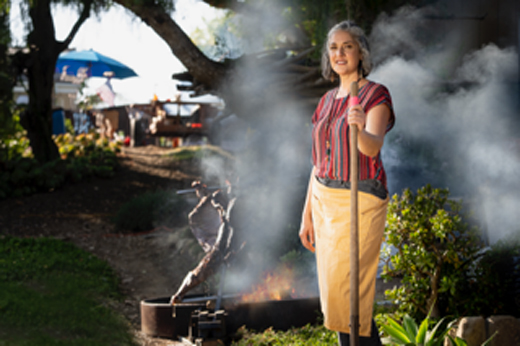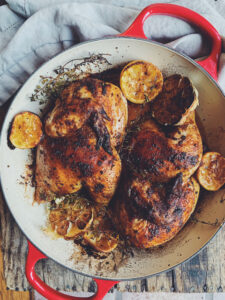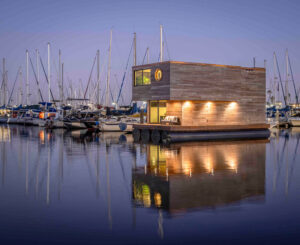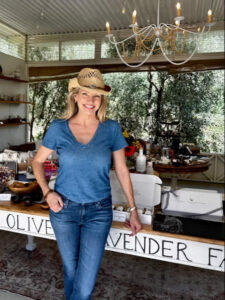
Santa Barbara private chef Aimee Cornejo is an experienced veteran at cooking large-scale asado-style events.
A melding of flavors and tradition
By Phil Kirkwood
Photos by Eliot Cowley
When the Spanish began colonizing Argentina in the 1600s, they brought with them cattle and a cooking method called asado, which literally means roast or roasted. The asado-style BBQ can be a 10-hour, slow roasting of beef, pork, or lamb over an outdoor fire pit of oak coals. Santa Barbara private chef Aimee Cornejo is an experienced veteran at cooking large-scale asado-style events. The most recent was a late-summer grill in the Santa Barbara foothills at the home of David and Wendy Laub, both longtime members of the local medical community.
“I would say my style of barbecuing comes from my Chilean culture roots around food as well as my time spent in Greece,” she said. “These experiences have opened my eyes to my love for cooking outdoors with family and friends. I have some South African friends and every year we get together and celebrate Braai Day by gathering and grilling a whole lamb or pig over a wood fire all day long. It doesn’t matter what I am cooking outside, a big paella or a shrimp boil, I very much enjoy sharing the process with others.
For the Laub party, Cornejo featured asado-style lamb and pork and served with Argentine chimichurri. She also utilized the hot ashes of the fire pit to bury and cook whole vegetables, including sweet potatoes, eggplant, peppers, and onions. This cooking method is called “rescoldo.” Wendy contributed fresh summer salads and homemade sausages braised in tomato sauce and a crudite platter with grilled pita bread as a starter. For the spices, Cornejo used fresh Italian parsley, cumin, crushed garlic, and lots of lemon juice as the core of her go-to spice mix. “They seem to go into just about everything I cook,” she said.
Cornejo graduated from the Culinary Arts School at Santa Barbara City College. For the last 20 years she’s been working as a chef in various locations, including owning her own catering company in California and in Chile, as well as head chef position in a resort town on the Island of Corfu in Greece. For her favorite “side gig,” she enjoys gardening and creating intimate sit-down suppers with seasonal menus for friends when they can truly relax, taste the food, and enjoy the company. “It doesn’t get much better than that.”
Chimichurri recipe
The key to this day’s asada menu was the chimichurri sauce and here is how chef Aimee prepared it.
“My go-to recipe for a traditional Chimichurri comes from none other than Francis Mallmann, author of ‘Seven Fires, Grilling the Argentine way.’ I find his recipe sticks to the traditions. He uses fresh parsley and oregano instead of dried, which is what the Gauchos would use. This recipe calls for a ‘salmuera’ for salt seasoning. A salmuera is a brine solution. Simply salt and water. In Argentina, they use it to season their meats while grilling them and for use in sauces. This recipe is not mine.
Chimichurri
The salmuera:
1 cup water
1 tablespoon coarse salt
1 head of garlic, separated into cloves and peeled
1 cup packed fresh flat-leaf parsley
1 cup fresh oregano
2 teaspoons crushed red pepper flakes
1/4 cup red wine vinegar
1/2 cup extra virgin olive oil
To make the salmuera, bring the water to a boil in a small saucepan. Add the salt and stir until it dissolves. Remove from heat and allow to cool.
Mince the garlic very fine and put in a medium bowl. Mince the parsley and oregano and add to the garlic, along with the red pepper flakes. Whisk in the salmuera. Transfer to a jar with a tight-fitting lid, and keep in the refrigerator. Best made at least a day in advance. The chimichurri can be kept refrigerated for up to 2 to 3 weeks.






